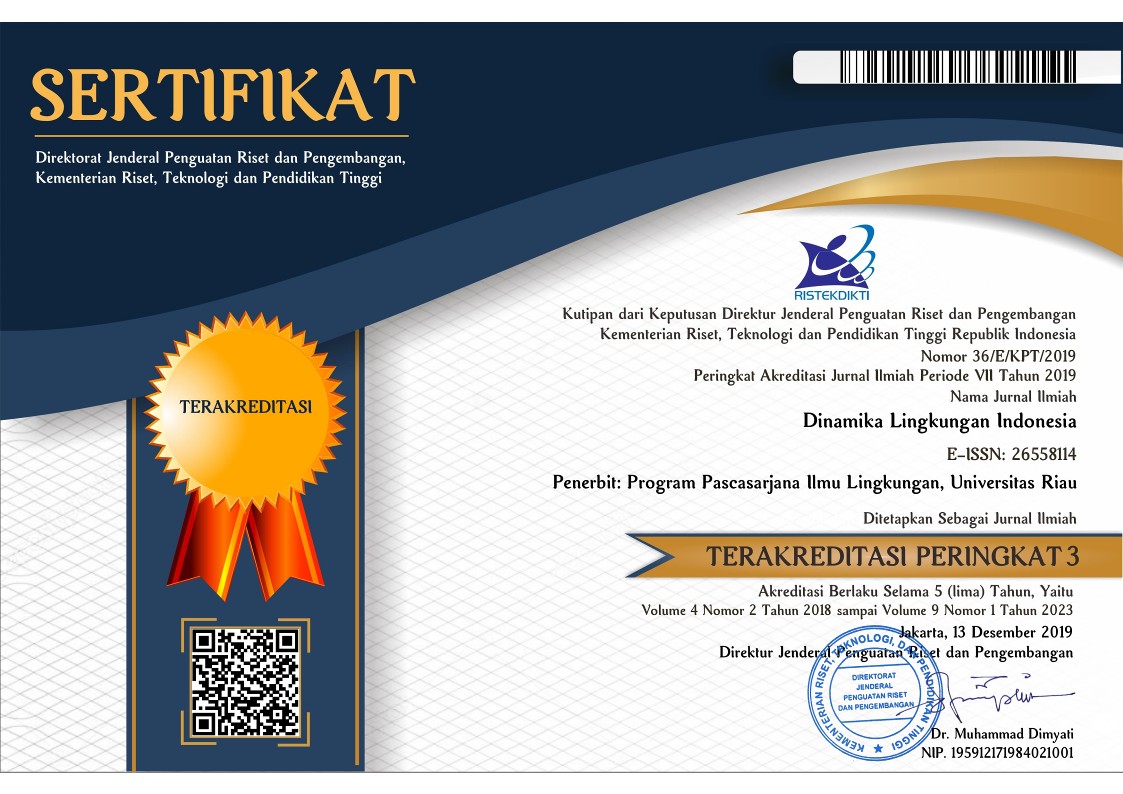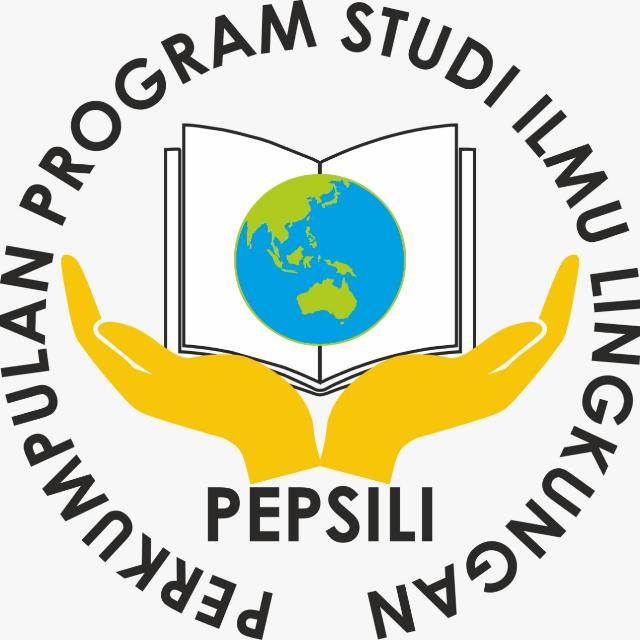Analisis Keberlanjutan Dimensi Sosial Budaya Usahatani Padi Sawah di Kabupaten Siak Provinsi Riau
Abstract
The study was conducted from January to July 2018 in four sub-districts (Bunga Raya, Sabak Auh, Sungai Apit and Sungai Mandau) in Siak Regency. The sample of farmers in this study were 203 people who were selected by purposive sampling. Data collection was done by interviewing techniques using questionnaires and field observations. The analysis of the sustainability of lowland rice farming was carried out based on the assessment of index and sustainability status using the Rap-Rice method in Multi-Dimensional Scaling (MDS). The purpose of this study was to analyze the index and the status of sustainability of the socio-cultural dimensions of wetland farming and analyze the role of each of the socio-cultural attributes that have sensitivity to the management of rice farming in the future. The results of Rap-Rice analysis of the seven socio-cultural attributes analyzed, two attributes provide sensitivity to the District (Bunga Raya, Sabak Auh and Sungai Mandau). Four attributes give sensitivity to Sungai Apit District. The attribute that gives sensitivity to all sub-districts is the attribute of attending training / counseling. Based on socio-cultural conditions, the analysis of wetland rice farming in Siak District showed a fairly sustainable category for Bunga Raya District (56.7%), Sabak Auh (50.80%) and Sungai Mandau (51.10%) while for Sungai Apit Subdistrict the value was obtained (47.70%) or less sustainable .
Keywords
Full Text:
PDFReferences
Abdollahzadeh, G. Sharifzadeh, MS. Damalas, CA. 2015. Perceptions of the beneficial and harmful effects of pesticides among Iranian rice farmers influence the adoption of biological control. Crop Protection. 75:124-131.
Alder J, TJ, Pitcher, D. Preikshot, K. Kaschner and B. Feriss. 2000. How good is good? A. Rapid Appraisal tecknique for evaluation of the sustainability status of fisheries of the north Atlantic. In Pauly and Pitcher (eds). Methods forevaluationg the impacts of fisheries on the north atlantic ecosystem. Fisheries Center Research Reports. 8(2):136-182.
Andayani, SA. Sanira. 2015. Pendapatan Usahatani Padi Sawah Berdasarkan Penerapan Sekolah Lapang Pengelolaan Tanaman Terpadu. Jurnal Ilmu Pertanian dan Peternakan. 3(2):42-29.
Dewi, MM. Utami, BW. Ihsaniyati, H. 2016. Motivasi Petani Berusahatani Padi (Kasus Di Desa Gunung Kecamatan Simo Kabupaten Boyolali). Jurnal Agrista. 4(3):104-114.
Fauzi, A dan S, Anna. 2005. Pemodelan Sumber Daya Perikanan dan Kelautan (untuk Analisis Kebijakan). Gramedia Pustaka Utama, Jakarta.
Fisheries Centre, 2002. Attributes of Rapfish Analysis for Ecological, Technological, Economic, Social and Ethical Evaluation Fields. Institute of Social and Ethical Evaluation Fields. Institute of Social and Economic Research Press. St John’s Canada.
Harahap, BH. Ginting, R. dan Hasyim. 2013. Pengaruh Sumber Daya Manusia (SDM) Petani Terhadap Petani Padi Sawah (Studi Kasus: Desa Pematang Setrak, Kec Teluk Mengkudu, Kab Serdang Bedagai). USU. Medan. Journal On Social Economic Of Agriculture and Agribusiness. 2(1):1-15.
Hermawan, H dan H, Andrianyta. 2013. Peran Tambahan Modal Terhadap Pendapatan Usahatani Padi di Kabupaten Blitar dan Ngawi, Jawa Timur. Jurnal Pengkajian dan Pengembangan Teknologi Pertanian, Balai Besar Pengkajia n dan Pengembangan Teknologi Pertanian. Badan Penelitian dan Pengembangan Pertanian. Kementerian Pertanian. Bogor. 16(2):143-158.
Kandaou, EE. 2010. Pengaruh Pelatihan dan Pengembangan Karyawan terhadap Produktivitas Kerja Karyawan (Studi pada PT. Air Manado). Jurnal Penelitian Ilmiah. 6(1):2-4.
Kavanagh, P. 2001. Rapid Appraisal of Fisheries (Rapfish) Project. Rapfish Software Description (for Microsoft Excel). University of British Columbia. Fisheries Centre. Vancouver, Canada. 36p.
Kavanagh, P and TJ, Pitcher. 2004. Implementing Microsoft Excel Software For Rapfish: A Technique for The Rapid Appraisal of Fisheries Status. University of British Columbia, Fisheries Centre Research Reports. 12 (2): 75 p.
Liu, F and H, Zhang. 2013. Novel Methods to Assess Environmental, Economic, and Social Sustainability of Main Agricultural Regions in China. Agronomy for Sustainable Development. 16(3):621-633.
Mardikanto, T. 2009. Pembangunan Pertanian. Tri Tunggal Tata Fajar. Surakarta.
Mudakir, B. (2011). Produktivitas Lahan dan Distribusi Pendapatan Berdasarkan Status Penguasaan Lahan Pada Usahatani Padi. Jurnal Dinamika Ekonomi Pembangunan. 1(1).
Nababan, MS. Efriyeldi dan Syafruddin, N. 2017. Struktur Komunitas Makrozoobenthos Pada Hutan Mangrove Di Desa Mengkapan Kecamatan Sungai Apit Provinsi Riau. Jurnal Perikanan dan Kelautan. 22(2):24-33.
Nurmalina, R. 2008. Analisis Indeks dan Status Keberlanjutan Sistem Ketersediaan Beras di Beberapa Wilayah Indonesia. Jurnal Argo Ekonomi. 26 (1):47-79.
Okonya, JS and Kroschel, J. 2016. “Farmers’ knowledge and perceptions of potato pests and their management in Uganda.” Journal of Agriculture and Rural Development in the Tropics and Subtropics. 117(1):87–97.
Pitcher, TJ. DB, Preikshot. 2001. Rapfish: A Rapid Appraisal Technique to Evaluate the Sustainability Status of Fisheries. Fisheries Research. 49(3): 255-270.
Rukka, H dan Wahab, A. 2013. FaktorFaktor yang Mempengaruhi Motivasi Petani dalam Pelaksanaan Kegiatan P2BN DI Kecamatan Barru, Kabupaten Barru. Jurnal Agrisistem. 1 (9) : 46-56.
Ryan, T. 2013. Sample Size Determination and Power. John Wiley and Sons.
Serageldin, I and Steer, A. 1994. Making Development Sustainable : From Consept to Action Enviromentally Sustainable Development Occasional Paper series No. 2. The Word Bank. Washinton D.C.
Shinta, A. 2011. Manajemen Pemasaran. Malang : UB Press.
Sitorus, SRP. 2004. Pengembangan Sumberdaya Lahan Berkelanjutan. Edisi ke-3. Bogor: Laboratorium Perencanaan Pengembangan Sumberdaya Lahan, Jurusan Tanah, Fakultas Pertanian, Institut Pertanian Bogor.
Sunaryo. 2006. Hubungan Karakteristik Petani Dengan Respon Petani Terhadap Penggunaan Pupuk Organik Pada Padi Sawah. Jurnal Agrisistem. 2 (1). Sekolah Tinggi Penyuluhan Pertanian.
Suryana, A. 2005. Pembangunan Pertanian Berkelanjutan Andalan Pembangunan Nasional. Makalah pada Seminar Sistem Pertanian Berkelanjutan untuk Mendukung Pembangunan Nasional. 15 Februari 2005. Universitas Sebelas Maret Solo.
Tesfamichael, D dan TJ, Pitcher. 2006. Multidisciplinary Evaluation of the Sustainability of Red Sea Fisheries Using Rapfish. Fisheries Research 78: 227-235.
Timprasert, S. Datta, A and Ranamukhaarachchi, S. 2014. Factors Determining Adoption of Integrated Pest Management by Vegetable Growers in Nakhon Ratchasima Province, Thailand. Crop Protection. 62:32-39.
Vildan, S. Nizamettin, B and Abdulkadir, C. 2009. Effect Of Formal Education And Tranining On Farmers Income. European Journal of Social Sciences. 7(3):52-62.
Wildemuth B. M., 2009. Application of Social Research Methods to Question in Informan and Library Science. Grennwood Publishing Group, London.
DOI: http://dx.doi.org/10.31258/dli.6.2.p.85-94
Refbacks
- There are currently no refbacks.





